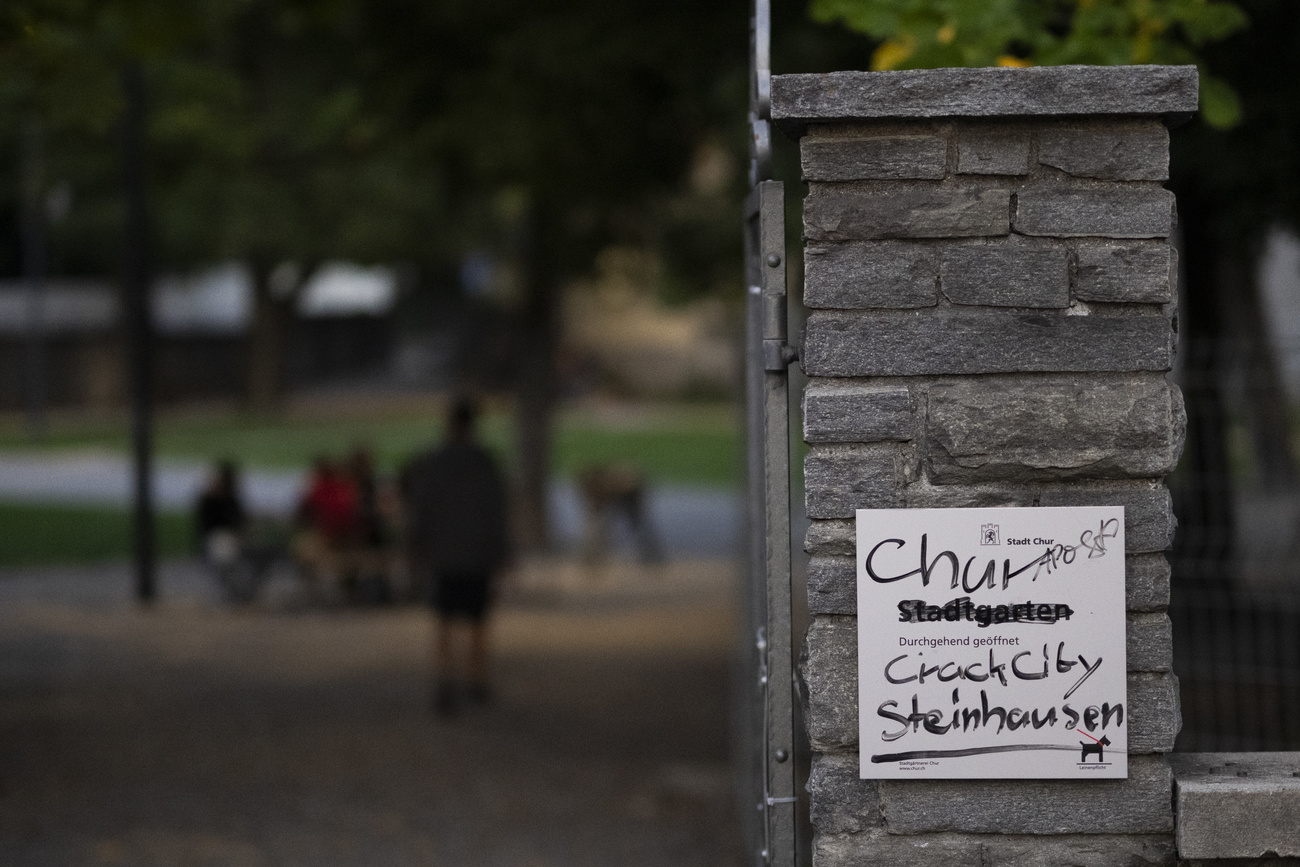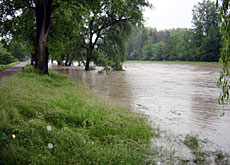Downpour puts Thun on flood alert

As towns across Switzerland struggle with floodwater, swissinfo waded to lakeside Thun where residents were braced for the worst.
Thun was put on high alert on Monday as the lake approached the record level of 1999, when flooding caused about SFr60 million ($47 million) in damage.
The flooding that year led to moves to build a pipeline to redirect excess water around the town. However, construction has yet to begin.
“The water level has been rising at an unusually rapid rate – between four and five centimetres an hour,” Jürg Alder, spokesman for the town council, told swissinfo on Monday.
Alder said if the water continued to rise “about 500 residents could be directly affected by flooding”.
It had already passed the critical mark of 558.30 metres above sea level by the start of the day – only 87cm below the 1999 record. (It reached 559.10 at 7 o’clock on Tuesday morning – only seven centimetres below the 1999 level.)
By 9am, the authorities opened emergency depots around the town where people could pick up sandbags and plastic sheeting. Civil-protection forces went from door to door distributing leaflets advising residents to remove valuables from their cellars and to seal drains.
Within two hours, one of the depots had been cleaned out of sandbags. “Even if it stops raining, the level will continue to rise because of the amount of water from the mountains still running into the lake,” said Marcel Sievers of Thun’s emergency task force.
The weather service, Meteotest, poetically described the heavy rain as being dropped from “clouds pressed against the mountains where they were squeezed like lemons”.
Lake Thun is Switzerland’s smallest body of water in relation to the size of its catchment area.
Remain calm
“Most people have remained calm and if they don’t, it’s our job to calm them,” Sievers said while manning a temporary information booth close to the lakeshore.
Several people gathered to watch men from the civil-protection service pile sandbags around a garden, which sits above an underground garage.
“We’re standing here wondering how long we should wait before removing everything from our cellars,” said resident Renate Looff, chatting nervously with neighbours beneath colourful umbrellas.
“When it rains like this, we expect our cellars to flood,” said René Schmutz. “We had SFr20,000 ($16,000) in damage to our garage and garden in 1999.”
“Six years ago, it wasn’t just our cellar that flooded but our living room as well,” Looff added.
“There’s no point getting sandbags, because they won’t help if the water reaches our house,” said Beat Schneeberger, surveying the rising waters. His cellar flooded in 1999, even though his house lies a couple of hundred metres from the lakeshore.
Prone to flooding
Thun has been prone to flooding since the early 18th century when a mountain river, the Kander, was redirected into the lake.
However, the 1999 flood was the worst on record. In May that year the snowmelt brought up to 700 cubic metres of water a second into the lake from the rivers Kander, Aare and Simme alone.
Around 350 buildings were affected and many residents had to be evacuated from their homes by boat.
The flood of the century put the local and cantonal authorities under pressure to prevent a repeat.
They finally put forward a plan to build an underground pipeline which would take water from the lake when levels are high and redirect it around Thun and into the Aare downstream from the town.
“It’s thought that the pipeline would ensure we avoid a repeat of a flood the size of the one in 1999,” said Alder.
But even if the project manages to overcome the last few bureaucratic hurdles, construction will not begin before next spring and it will not be completed until the end of 2007.
swissinfo, Dale Bechtel in Thun
The Lake Thun water level rose to a record 559.12 metres above sea level in May 1999.
About 350 buildings were flooded, with damage estimated at around SFr60 million.
The town council and cantonal authorities plan to build a pipeline under Thun, to relieve the town when the water rises to dangerously high levels.
The SFr31 million project is not expected to be completed before the end of 2007.

In compliance with the JTI standards
More: SWI swissinfo.ch certified by the Journalism Trust Initiative











You can find an overview of ongoing debates with our journalists here . Please join us!
If you want to start a conversation about a topic raised in this article or want to report factual errors, email us at english@swissinfo.ch.